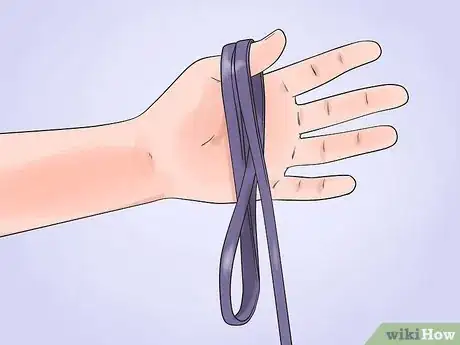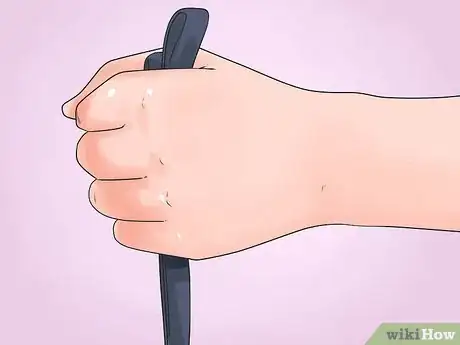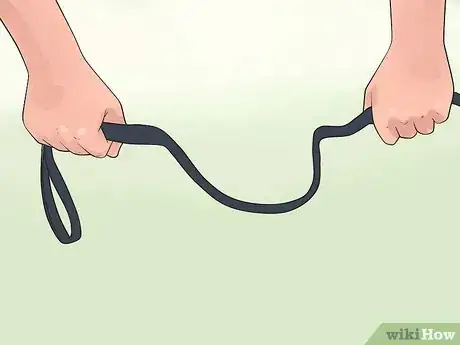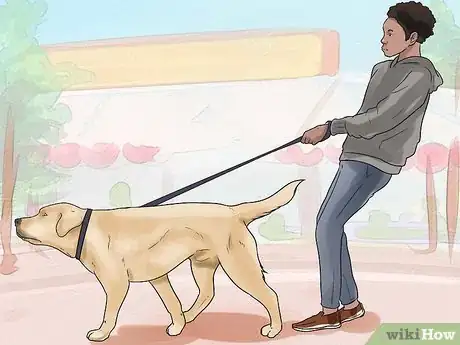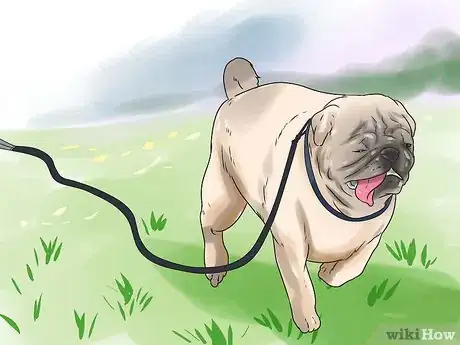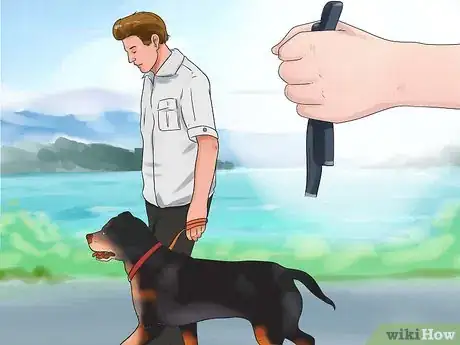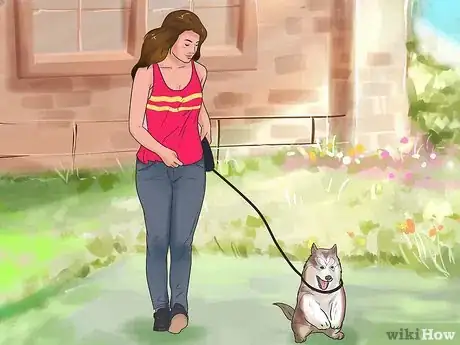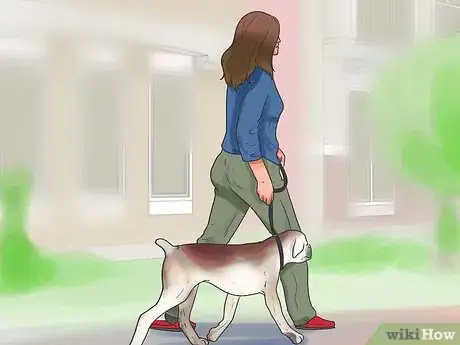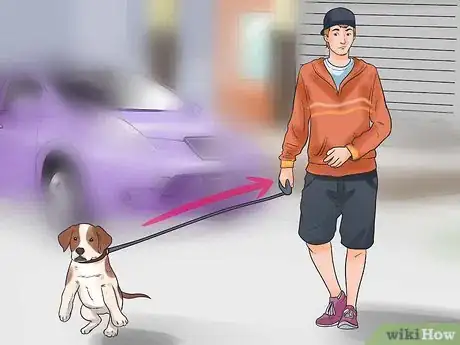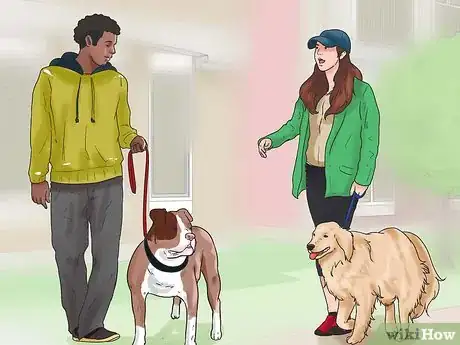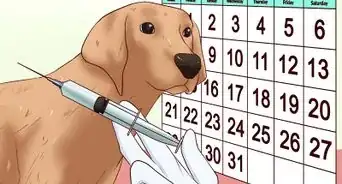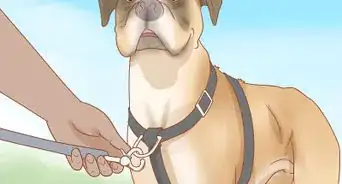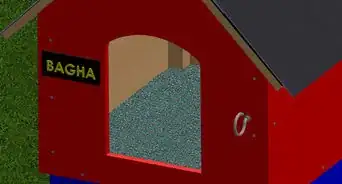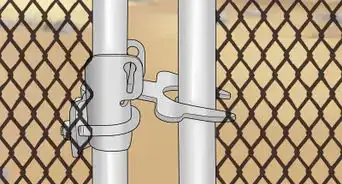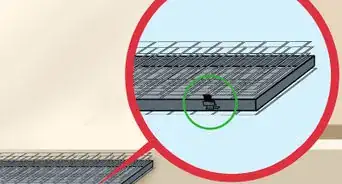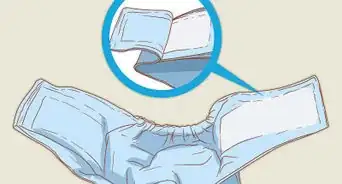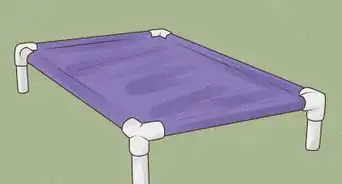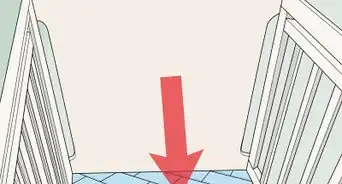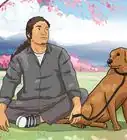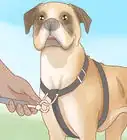This article was co-authored by Beverly Ulbrich. Beverly Ulbrich is a Dog Behaviorist and Trainer and the Founder of The Pooch Coach, a private dog training business based in the San Francisco Bay Area. She is a Certified CGC (Canine Good Citizen) Evaluator by the American Kennel Club and has served on the Board of Directors for the American Humane Association and Rocket Dog Rescue. She has been voted the best private dog trainer in the San Francisco Bay Area 4 times by SF Chronicle and by Bay Woof, and she has won 4 "Top Dog Blog" awards. She has also been featured on TV as a dog behavior expert. Beverly has over 18 years of dog behavior training experience and specializes in dog aggression and anxiety training. She has a Master of Business Administration from Santa Clara University and a BS from Rutgers University.
There are 11 references cited in this article, which can be found at the bottom of the page.
This article has been viewed 52,937 times.
Holding a dog’s leash may seem straight-forward, but there are several things to consider. The way you hold the leash not only helps you stay safe, it helps you control your dog. Teaching your dog to walk on a leash will also ensure you both have a pleasant time when on a walk.
Steps
Holding a Leash
-
1Use just your thumb. Slip your thumb through the loop at the end of the leash. If you hold your hand upwards in front of you (like you’re giving someone a high five), the leash should dangle off your thumb. Then close your hand around the loop. The rest of the leash should come out the bottom of your fist, beside your pinky finger.[1]
-
2Fold the leash in your hand. Do not wrap the leash around your hand or arm. Instead, fold the leash several times and hold the folds in your hand. Make sure the end of the leash is coming out of the bottom of your fist, near your pinky finger.[2]
- Wrapping the leash around your arm or hand can cause serious injury if your dog suddenly pulls hard, or if the leash gets tangled in something. This could break a bone or cut off circulation.
Advertisement -
3Hold the leash with both hands. While walking it is best to hold the leash with both of your hands, not one. Your right hand should the end of the leash, with your right thumb through the loop. Excess portions of the leash should be folded into your right hand. Your left hand should be holding a section of the leash closer to your dog.[3]
- There should be enough slack between your two hands that the leash forms a U shape in front of you. There should also be enough slack between your left hand and your dog so your dog is not uncomfortable.
- Hold your arms down at your sides, not bent upwards or even above your head.
-
4Stand on the leash when you’re stopped. If you decide to stop at any point while on a walk with your dog, put your foot on a part of the leash and stand on it. This will provide you with more stability and resistance if your dog starts to pull or run away.[4]
- Alternatively, fold the leash into both your hands and hold it in front of you with both hands. Your hands should be vertical, one on top of the other, like you’re holding a baseball bat.
-
5Stabilize your body if your dog pulls. If your dog starts to pull on the leash, stand up straight and point your hip in the direction your dog is pulling. Stand with your feet shoulder width apart. This will stabilize you so that you aren’t pulled off-balance if your dog continues to pull on the leash.[5]
- Dogs that encounter resistance will stop pulling faster than those who do not encounter resistance. By not building a resistance to your dog’s pulling, they will learn that they can keep doing it until you give in (or fall over).
Training Your Puppy
-
1Reward good behaviour. Treats (in the form of pieces of kibble) should only be given to the puppy when they’ve performed the correct behaviour. And the reward should be given immediately after the good behaviour. If you cannot get to your puppy quick enough after the good behaviour, it’s better to forego the treat altogether.[6]
- While training a puppy it’s helpful to keep a belted pack around your waist so you have easy (and quick) access to treats when needed.
-
2Practice sitting and following first. Before attaching a leash to your puppy, teach your puppy to stay seated and pay attention. Reward your puppy for staying seated. Then, run away and get get your puppy to chase you. Stop after 5-7 steps and wait for your puppy to sit down before handing out the reward.[7]
- The point of this training process is to teach your puppy to sit and follow properly, without the added pressure of a leash. Your puppy needs to think this process is fun.
-
3Let the puppy drag a leash. Attach a lightweight leash to your puppy’s collar. Practice the sit and follow routine, but do not hold the leash. Allow the puppy to drag the leash around. Reward your puppy for performing the sit and follow routine properly.[8]
- Make sure there aren’t any obstacles where the leash can get caught.
-
4Allow slack in the leash. When standing and walking normally, the leash should be held with enough slack that the puppy’s collar isn’t being pulled tightly around its neck. If your puppy moves too far from you, it may pull. But your puppy will soon learn that staying closer to you is more comfortable.[9]
- The more pressure and discomfort a puppy is feeling, the more they’ll fight back.
-
5Hold the leash below your waist. When holding the leash while on a walk, your hands should be down by your sides. Your right hand should be against your right thigh (with the loop of the leash in your thumb), and your left arm should be against your left thigh (holding a portion of the leash in your fist).[10]
- Never wrap the leash around your hand or wrist on either side of your body, this can cause serious injury.
-
6Shorten and lengthen the leash as needed. When the puppy is stopped beside you, you may need to fold excess parts of the leash into your hand. But when the puppy (and you) start to move, you may need to allow a couple of the folds to come out of your hand.[11]
- Avoid holding the leash in one spot and raising and lowering your hands to lengthen and shorten the leash. This will cause you to inadvertently hold the least too tightly.
Walking Your Dog
-
1Use a hands-free leash. A hands-free leash is a leash that has a belt, instead of a loop, at the end. You wear the belt around your waist with your dog’s leash attached to the belt. In general the process for walking your dog is the same.[12]
- There are two great benefits for using a hands-free leash. One is the obvious, you’re hands are free. This makes it easier to reward your dog for good behaviour, and swing your arms if you’re walking quickly or running. Two is that the main point of resistance to your dog is the middle of your body, right near your centre of gravity. This makes you significantly more stable than holding the leash in your hands.
-
2Select the right leash. When you go to the pet store to buy a leash, you’ll notice they come in every material, length and colour you can imagine. The colour you choose is completely up to you! The length should be based on the type of activity you’ll be performing with your dog. And the material should be based on personal comfort and expense.[13]
- If you’re taking your dog for a loose leash walk, a leash that has the ability to uncoil and recoil is very useful. Instead of folding pieces of the leash in your hands, you can simply click a button and allow your dog to uncoil the rope. These leashes, however, are not designed for heel walks, or walks where there are a lot of obstacles for a rope to get caught on (including people and other dogs).
- Leashes can be made of metal chains, leather or nylon. Here are some things you may want to consider when choose the material of a leash:
- Metal - looks cool, but is heavy. Can prevent a dog from attempting to bite the leash.
- Leather - expensive, but easy to hold and use. The leather may not be as flexible in cold weather.
- Nylon - the least expensive, and has the most variety. Stands up after constant exposure to different weather conditions. But can be hard on the hands.
-
3Run with your dog. Many dog owners enjoy bringing their dogs when going for a run, a bike ride, or rollerblading. This offers great exercise to both you and your dog, and should hopefully tire your dog out faster![14]
- Remember to control your dog throughout the run. Since it is a run, don’t allow your dog to stop unless you do. You both should be able to maintain the same, steady pace.
-
4Walk with your dog. Your dog should have more slack on the leash while walking, than while standing still. They should always feel comfortable in their leash and collar to avoid injury and misbehaviour. When walking, your dog should be immediately to your side (which side will depend on what’s more comfortable to you). Your dog should not walk behind or in front of you.[15]
- If you allow your dog to walk behind you on a leash, there’s a great chance you’ll pull too hard on the leash in order to force the dog to keep up with you.
-
5Pull backwards on the leash to stop. Your right hand should be holding the end of the leash, with your thumb through the loop and excess leash folded in your hand. Your left hand should be holding another section of the leash, closer to your dog. Your left hand should be down near your left thigh. When it’s time to stop, simply pull backwards with your left hand.[16]
- There should be some slack in the leash between your two hands AND between your left hand and your dog.
- When you’re ready to move again, start walking forward. Your left arm will naturally pull on the leash and signal your dog it’s time to go. Don’t yank on the leash.
-
6Practice ignoring distractions. One of the worst situations most owners encounter when taking their dog for a walk is what happens when another person or another dog walk by. You dog may walk perfectly if there’s no one around, but the moment there’s a distraction, your dog may completely forget everything they've learned. That’s why it’s important to train your dog to ignore distractions while on a walk.[17]
- When practicing, use a friend or family member as the distraction, rather than practicing on unsuspecting strangers.
- While learning to ignore distractions, you may find the use of a head halter beneficial. A head halter has a nylon strap that goes around your dog’s snout. And the leash connects to the halter under your dog’s chin. Both of these added features provide you with more control of what your dog is looking at. Teaching your dog to ignore a distraction has a lot to do with making your dog pay attention to you, and only you.[18]
- There are several methods you can teach your dog:[19]
- Avoidance - Sometimes the problem isn’t your dog, but maybe the dog coming in the opposite direction. Instead of walking past the oncoming dog, train your dog to reverse directions.
- The L Pattern - The L pattern method can be used to position your dog off to the side of the path you’re on, facing away from the path. If you see something distracting coming towards you, turn your dog to the left or right. Walk your dog just off the path and use the sit command. Keep your dog sitting there - looking at you - until the distraction has gone by.
- Repeated Sits - When you see a distraction coming towards, regardless of whether they’ll pass on your left or right side, repeated sit trains your dog to sit and face you. Your dog remains sitting until the distraction has passed. Depending on the situation, you can train your dog to sit facing away from the oncoming distraction, or facing the distraction with their head tilted away, looking at you.
- Speed Up - Most methods require that you stop your dog while the distraction is near, and wait to resume your walk after the distraction has passed. An alternative is to simply pick up the pace when the distraction approaches, and slow down again after the distraction passes.
Expert Q&A
-
QuestionWhat length dog leash is best?
 Beverly UlbrichBeverly Ulbrich is a Dog Behaviorist and Trainer and the Founder of The Pooch Coach, a private dog training business based in the San Francisco Bay Area. She is a Certified CGC (Canine Good Citizen) Evaluator by the American Kennel Club and has served on the Board of Directors for the American Humane Association and Rocket Dog Rescue. She has been voted the best private dog trainer in the San Francisco Bay Area 4 times by SF Chronicle and by Bay Woof, and she has won 4 "Top Dog Blog" awards. She has also been featured on TV as a dog behavior expert. Beverly has over 18 years of dog behavior training experience and specializes in dog aggression and anxiety training. She has a Master of Business Administration from Santa Clara University and a BS from Rutgers University.
Beverly UlbrichBeverly Ulbrich is a Dog Behaviorist and Trainer and the Founder of The Pooch Coach, a private dog training business based in the San Francisco Bay Area. She is a Certified CGC (Canine Good Citizen) Evaluator by the American Kennel Club and has served on the Board of Directors for the American Humane Association and Rocket Dog Rescue. She has been voted the best private dog trainer in the San Francisco Bay Area 4 times by SF Chronicle and by Bay Woof, and she has won 4 "Top Dog Blog" awards. She has also been featured on TV as a dog behavior expert. Beverly has over 18 years of dog behavior training experience and specializes in dog aggression and anxiety training. She has a Master of Business Administration from Santa Clara University and a BS from Rutgers University.
Dog Behaviorist & Trainer I advocate having a very short leash at all times, unless the dog is sniffing to go to the bathroom. It's much easier to have your dog under control when they're right next to you, and they won't round a corner and run into something dangerous, like an aggressive dog.
I advocate having a very short leash at all times, unless the dog is sniffing to go to the bathroom. It's much easier to have your dog under control when they're right next to you, and they won't round a corner and run into something dangerous, like an aggressive dog. -
QuestionHow do you keep a dog's attention while walking?
 Beverly UlbrichBeverly Ulbrich is a Dog Behaviorist and Trainer and the Founder of The Pooch Coach, a private dog training business based in the San Francisco Bay Area. She is a Certified CGC (Canine Good Citizen) Evaluator by the American Kennel Club and has served on the Board of Directors for the American Humane Association and Rocket Dog Rescue. She has been voted the best private dog trainer in the San Francisco Bay Area 4 times by SF Chronicle and by Bay Woof, and she has won 4 "Top Dog Blog" awards. She has also been featured on TV as a dog behavior expert. Beverly has over 18 years of dog behavior training experience and specializes in dog aggression and anxiety training. She has a Master of Business Administration from Santa Clara University and a BS from Rutgers University.
Beverly UlbrichBeverly Ulbrich is a Dog Behaviorist and Trainer and the Founder of The Pooch Coach, a private dog training business based in the San Francisco Bay Area. She is a Certified CGC (Canine Good Citizen) Evaluator by the American Kennel Club and has served on the Board of Directors for the American Humane Association and Rocket Dog Rescue. She has been voted the best private dog trainer in the San Francisco Bay Area 4 times by SF Chronicle and by Bay Woof, and she has won 4 "Top Dog Blog" awards. She has also been featured on TV as a dog behavior expert. Beverly has over 18 years of dog behavior training experience and specializes in dog aggression and anxiety training. She has a Master of Business Administration from Santa Clara University and a BS from Rutgers University.
Dog Behaviorist & Trainer It's all about your energy—you have to think of yourself as a leader and be very purposeful and alert. In the wild, the lead animal is always the most intense, energetic animal in the bunch; the one who's the most focused on getting the pack from point A to point B every day. The walk is really you saying, "I'm in charge, I'm taking you for a walk because that's my job."
It's all about your energy—you have to think of yourself as a leader and be very purposeful and alert. In the wild, the lead animal is always the most intense, energetic animal in the bunch; the one who's the most focused on getting the pack from point A to point B every day. The walk is really you saying, "I'm in charge, I'm taking you for a walk because that's my job."
Warnings
- Do not use choke chains on your dog. They can cause serious injury to your dog.⧼thumbs_response⧽
References
- ↑ http://www.aspcapro.org/how-to-hold-a-leash
- ↑ http://www.aspcapro.org/how-to-hold-a-leash
- ↑ http://drsophiayin.com/blog/entry/safe-or-unsafe-leash-handling
- ↑ http://www.aspcapro.org/how-to-hold-a-leash
- ↑ http://www.aspcapro.org/how-to-hold-a-leash
- ↑ http://drsophiayin.com/blog/entry/my-puppy-wont-walk-on-leash-3-ways-to-train-your-puppy-to-love-her-leash
- ↑ http://drsophiayin.com/blog/entry/my-puppy-wont-walk-on-leash-3-ways-to-train-your-puppy-to-love-her-leash
- ↑ http://drsophiayin.com/blog/entry/my-puppy-wont-walk-on-leash-3-ways-to-train-your-puppy-to-love-her-leash
- ↑ http://www.petmd.com/dog/puppycenter/training/evr_dg_how_to_properly_hold_a_dog_leash
- ↑ http://www.petmd.com/dog/puppycenter/training/evr_dg_how_to_properly_hold_a_dog_leash
- ↑ http://drsophiayin.com/blog/entry/safe-or-unsafe-leash-handling
- ↑ http://drsophiayin.com/blog/entry/regular-leash-vs-hands-free-waist-leash-which-is-safer-when-your-dog-pulls
- ↑ https://www.aspca.org/pet-care/dog-care/dog-walking-101
- ↑ http://gearjunkie.com/running-with-your-dog
- ↑ http://drsophiayin.com/blog/entry/safe-or-unsafe-leash-handling
- ↑ http://drsophiayin.com/blog/entry/leash-walking-tips-giving-correct-cues-for-stopping
- ↑ http://drsophiayin.com/blog/entry/reactive-dog-moving-past-distractions
- ↑ http://www.aspca.org/pet-care/virtual-pet-behaviorist/dog-behavior/dogs-who-are-reactive-leash
- ↑ http://drsophiayin.com/blog/entry/reactive-dog-moving-past-distractions
- ↑ http://yourdogsfriend.org/help/pulling-on-leash/
About This Article
To hold a dog's leash, start by slipping your right thumb through the loop at the end of the leash. Next, fold the length of the leash several times and close your right hand around the loop. Let the rest of the leash dangle from the bottom of your right fist, beside your pinky finger. As you're walking your dog, keep the leash secured in your right hand and use your your left hand to hold a section of the leash closer to your dog. If you need to stop at any point, put your foot on a part of the leash and stand on it to provide extra stability. For tips on how to react if your dog starts pulling on the leash, read on!
